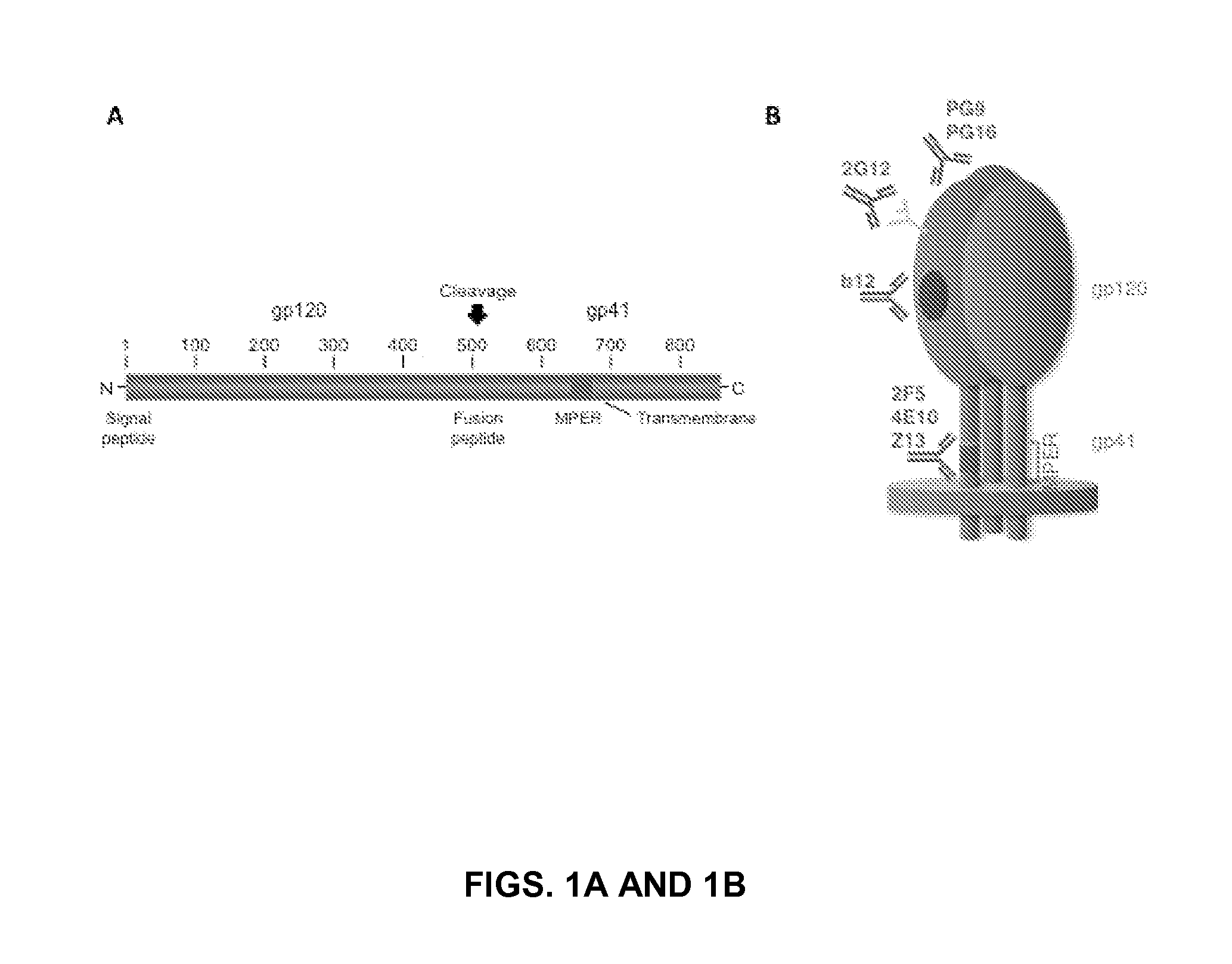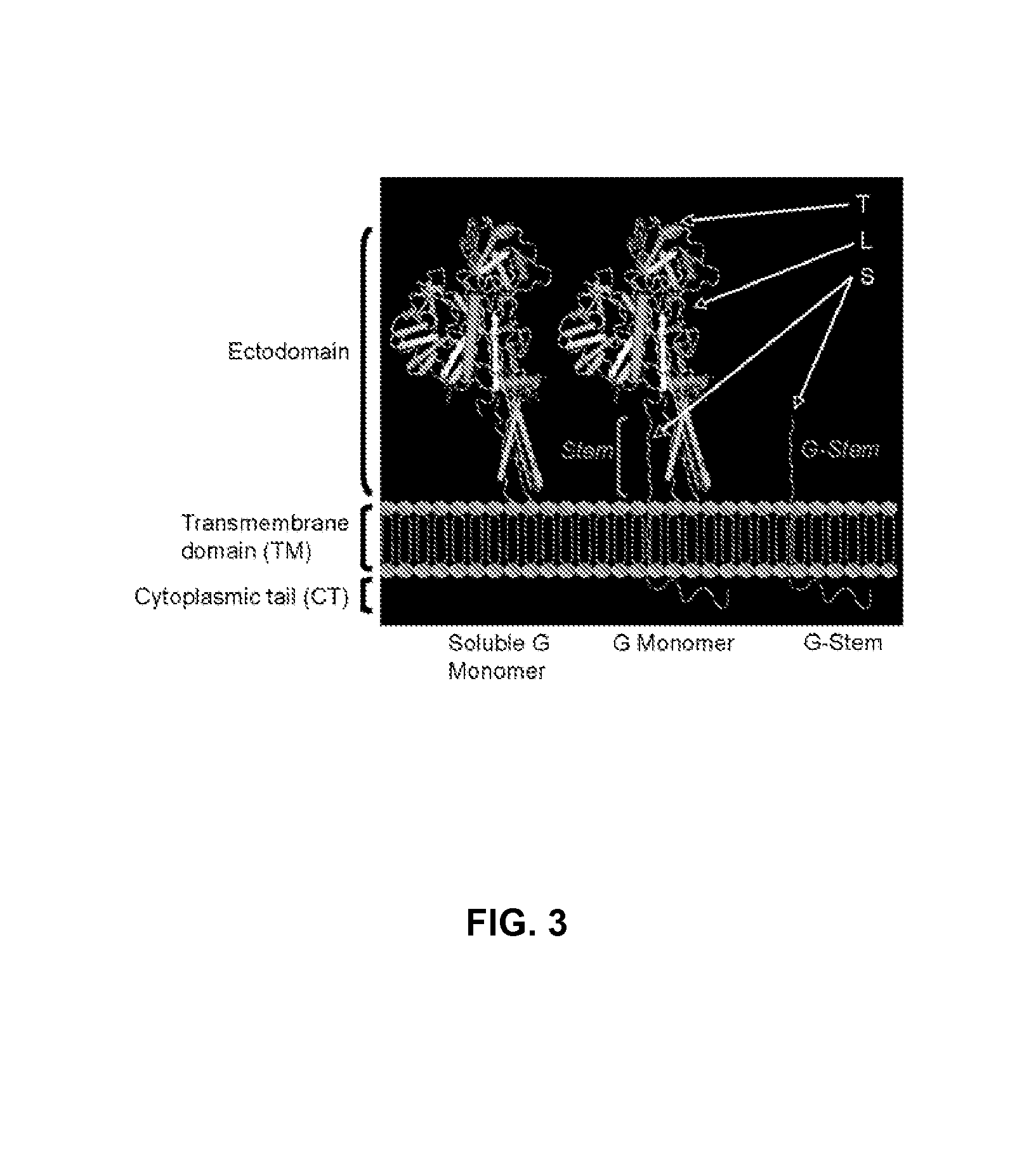Recombinant viral vectors
a technology of vesicular stomatitis virus and vector, which is applied in the field of recombinant vesicular stomatitis virus, can solve the problems that none of these approaches have yet efficiently elicited neutralizing antibodies with broad specificity, seriously impairing the body's ability to fight most invaders, etc., and achieves the effect of increasing the stability of the functional trimeric form of env or envg and es
- Summary
- Abstract
- Description
- Claims
- Application Information
AI Technical Summary
Benefits of technology
Problems solved by technology
Method used
Image
Examples
example 1
Insertion of the HIV-1 gp41 Epitopes 2F5 and 4E10 into the Membrane-Proximal Region of the Vesicular Stomatitis Virus Glycoprotein
[0129]The membrane-proximal external region (MPER) of HIV-1 gp41, which is recognized by the broadly neutralizing monoclonal antibodies 2F5 and 4E10, is an important target for an HIV vaccine. However, efforts to mimic the 2F5 and 4E10 epitopes outside the context 30 of the gp41 MPER have had minimal success so far. In this study, Applicants used the envelope glycoprotein G of Vesicular Stomatitis Virus (VSV) as a scaffold. VSV G, which forms homotrimeric spikes on the viral surface, is responsible for binding of the virus to cells and promotes fusion of the viral and cellular membranes. The “stem” region of VSV G, which lies immediately N-terminal of its single transmembrane segment, shares sequence similarities with the gp41 MPER. Applicants inserted the gp41 sequences corresponding to the 2F5 and 4E10 neutralizing epitopes into the stem region of VSV G...
example 2
Using VSV Vectors to Display and Evolve Novel HIV Envelope Immunogens
[0130]The goal of this Example is to design and develop novel HIV-1 envelope protein (Env) immunogens capable of eliciting broadly protective neutralizing antibody responses for use as vaccine candidates. Applicants take advantage of the unique biological properties of vesicular stomatitis virus (VSV) as vaccine delivery vehicle to present and effectively deliver HIV Env immunogens. In addition, Applicants use the high evolutionary potential of VSV to biologically derive unique mutant HIV Envs with enhanced immunogenicity. Novel candidates are used to vaccinate rabbits to determine their capacity to elicit antibodies with enhanced HIV neutralizing activity, and those VSV-vectored vaccines that evoke responses with increased breadth of neutralization are tested in macaques. Applicants achieve these goals by completing the Specific Aims below:[0131]1. Vaccine Platform 1: Optimize HIV Env (derived from SHIVSF162P3) fo...
example 3
Optimization of Immunogen Presentation by G-Stem Vectors
[0135]To develop a platform that can be used to display immunogens on the surface of virus particles or infected cells, Applicants have engineered vesicular stomatitis virus (VSV) vectors to encode a truncated form of the viral transmembrane glycoprotein protein (G) that can be modified to express foreign epitopes anchored to virus envelop or cell membrane. The truncated form of G, called G-Stem (FIG. 18A), retains amino acid sequences that are essential for directing insertion of the molecule into the membrane (the signal peptide), anchoring the protein in the viral envelop or cellular lipid bilayer (the transmembrane domain; TM), and promoting incorporation into the budding viral particle (C-terminal domain). Additionally, a small membrane proximal region of the external domain of G (the Stem) is retained in most constructs because it provides a short stalk on which to append epitopes (FIG. 18B), and importantly, sequences in...
PUM
| Property | Measurement | Unit |
|---|---|---|
| time | aaaaa | aaaaa |
| time | aaaaa | aaaaa |
| time | aaaaa | aaaaa |
Abstract
Description
Claims
Application Information
 Login to View More
Login to View More - R&D
- Intellectual Property
- Life Sciences
- Materials
- Tech Scout
- Unparalleled Data Quality
- Higher Quality Content
- 60% Fewer Hallucinations
Browse by: Latest US Patents, China's latest patents, Technical Efficacy Thesaurus, Application Domain, Technology Topic, Popular Technical Reports.
© 2025 PatSnap. All rights reserved.Legal|Privacy policy|Modern Slavery Act Transparency Statement|Sitemap|About US| Contact US: help@patsnap.com



